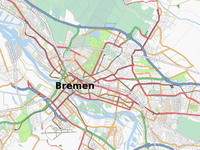Key:place
| Description |
|---|
| Defines the center or outline of a named place |
| Group: places |
| Used on these elements |
| Documented values: 31 |
| Requires |
|
| Useful combination |
|
| See also |
| Status: de facto |
| Tools for this tag |
|
- Main article: Places
Used to indicate that a particular location is known by a particular name, to indicate what sort of "place" it is. A place tag should exist for every significant human settlement (city, town, suburb, etc.) regardless of administrative status, and also for notable unpopulated, named places.
Usage
Nodes
The simplest and most widespread way to map most place types is to position a node roughly at its centre (for a populated place having a central town hall, square or similar, preferably there).
Areas
If a place has a fairly well defined and verifiable outline it can make sense to map it as an area. This allows to precisely define the extent of the place, which can be very helpful for example when using Nominatim for address queries etc (as the results returned otherwise can often be quite confusing because of "noise" from nearby, but unrelated, place nodes ).
Note that for some applications, in particular for routing programs, not having a well placed centre node can cause problems because they'll then have to calculate a "centroid" from the area geometry, which in some cases can be very inaccurate. For smaller populated places (hamlets, villages, small towns) this is rarely a significant problem though (as most people would usually just want to be navigated to the place, not necessarily to some random mappers pick of a "centre" in it).
place=island and place=islet for example typically have a well defined outline and no defined centre so they are normally mapped as areas. Very large places like place=continent, place=ocean and place=sea are by convention always mapped as nodes.
Mapping populated places as areas
Populated places (in particular place=city, place=town, place=village, place=hamlet and place=isolated_dwelling) are usually mapped as nodes since in most cases they have a well defined centre but not a verifiable outline. Some mappers map populated places as areas none the less with the geometry representing one of the following:
- The smallest administrative unit the place is part of and that fully includes the place. This often conflicts with the administratively declared places listed below and often includes areas that are not commonly considered part of the populated place.
- An aggregate/merger of urban landuses that are considered to belong to the place. This creates difficulties in particular in regions with larger agglomerations and connected settlements where it is often not clear where exactly one place starts and another one ends.
- An approximate hull polygon drawn around all parts of the populated place but not meant to represent a meaningful outline.
Because of the lack of verifiability and the different conflicting ideas for the meaning of the outline and because the well defined centre of the place which is useful and important for many applications is not part of such mapping it is not advisable for mappers to map populated places as areas but to map them as nodes. Data users should not expect the area geometries of populated places to have a particular meaning.
Populated places mapped as areas do not render in the openstreetmap-carto stylesheets. This is intentional, as documented at the Openstreetmap Carto GitHub project. Settlements mapped as areas are rendered in some other maps (e.g. Osmand, Mapscii, Transport Map, Mapbox).
Additional tags
If you have a way of knowing the population of a place (from a free data source), the population=* tag typically is added to the same object the place tag appears on.
Also useful is the addition of wikidata=*/wikipedia=*.
Values
This is a table showing commonly used place=* tags separated into categories.
Administratively declared places
This table is a wiki template with a default description in English. Editable here.
Populated settlements, urban
This table is a wiki template with a default description in English. Editable here.
Populated settlements, urban and rural
This table is a wiki template with a default description in English. Editable here.
Other places
This table is a wiki template with a default description in English. Editable here.
Additional attributes
This table is a wiki template with a default description in English. Editable here.
Relationship with admin_level
When a place is also a level of government with the exact same extension, it should be tagged with admin_level=*. Generally place entities tend to differ from administrative entities of the same name because the administrative entities contain areas outside the settlement, like fields and forests. The exact level varies significantly from country to country; but as an approximation, places line up with admin levels as follows:
| Place | Admin level |
|---|---|
| country | 2–3[1] |
| state, province, region | 3–5 |
| district, county | 4–8 |
| subdistrict, municipality | 6–8 |
| city | 6–9 |
| town, village, hamlet | 7–10 |
| borough, suburb | 8–10 |
| quarter, neighbourhood, block | 8–11 |
- ↑ The vast majority of place=country correspond with admin_level=2. place=country with admin_level=3 is rare and may occur for non-sovereign countries with high degrees of autonomy, for example the constituent countries of the Kingdom of the Netherlands.
See also
- border_type=* - Border type is used to mark the difference between different types of borders, such as maritime boundaries or imported borders.
- place:CN=* - a China-specific tag used on places to indicate the type of administrative in China.
